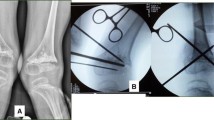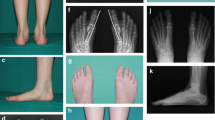Abstract
Purpose
Angular deformities of the knee resulting from idiopathic, congenital, or acquired causes are commonly encountered in pediatric orthopedics. Whereas physiological deformities should be treated expectantly, the remaining often progress enough to warrant operative treatment, despite attempted bracing. Historical methods of surgical treatment (e.g., epiphysiodesis and stapling) have yielded to the increasingly popular method of reversible guided growth using the eight-Plate.
Methods
We studied 58 patients with knee angular deformities managed with eight-Plate guided growth. All etiologies except physiological deformities and those with very slow growth rate were included. Each patient was under appropriate medical management during the entire duration of treatment and after plate removal.
Results
In the dysplasia/syndrome group, we noted complete correction in 22 patients (78.5%), partial correction in 5 (17.9%), and no correction in 1 patient (3.6%). All cases of idiopathic deformities resolved. Patients with osteochondral dysplasias and genetic syndromes underwent earlier intervention and slower correction than those with idiopathic genu varum or valgum. The time difference in reaching a neutral mechanical axis between the two groups (11 months in idiopathic versus 18 months in pathological physis) could be explained by a significant difference in growth speeds (P = 0.003).
Conclusion
Results indicate that early intervention is advisable for patients with osteochondral dysplasias/syndromes as subsequent correction takes longer. If rebound growth causing recurrent deformity occurs, guided growth can be safely repeated. Additionally, complications reported with other techniques such as hardware failure, physeal violation by the implant, premature physeal closure, and overcorrection were not reported while using the eight-Plate.





Similar content being viewed by others
References
Stevens P (2006) Guided growth: 1933 to the present. Strategies Trauma Limb Reconstr 1(1):29–35
Brooks WC, Gross RH (1995) Genu varum in children: diagnosis and treatment. J Am Acad Orthop Surg 3(6):326–335
Fabry G, MacEwen GD, Shands AR Jr (1973) Torsion of the femur. A follow-up study in normal and abnormal conditions. J Bone Joint Surg Am 55(8):1726–1738
Stevens PM, Klatt JB (2008) Guided growth for pathological physes: radiographic improvement during realignment. J Pediatr Orthop 28(6):632–639
Mycoskie P (1981) Complication of osteotomies about the knee in children. Orthopedics 4:1005–1015
Steel HH, Sandrow RE, Sullivan PD (1971) Complications of tibial osteotomy in children for genu varum or valgum. Evidence that neurological changes are due to ischemia. J Bone Joint Surg Am 53(8):1629–1635
Blount WP, Clarke GR (1949) Control of bone growth by epiphyseal stapling; a preliminary report. J Bone Joint Surg Am 31A(3):464–478
Bylski-Austrow DI, Wall EJ, Rupert MP, Roy DR, Crawford AH (2001) Growth plate forces in the adolescent human knee: a radiographic and mechanical study of epiphyseal staples. J Pediatr Orthop 21(6):817–823
Frantz CH (1971) Epiphyseal stapling: a comprehensive review. Clin Orthop Relat Res 77:149–157
Zuege RC, Kempken TG, Blount WP (1979) Epiphyseal stapling for angular deformity at the knee. J Bone Joint Surg Am 61(3):320–329
Brockway A, Craig WA, Cockreli BR Jr (1954) End-result study of sixty-two stapling operations. J Bone Joint Surg Am 36(5):1063–1070
Mielke CH, Stevens PM (1996) Hemiepiphyseal stapling for knee deformities in children younger than 10 years: a preliminary report. J Pediatr Orthop 16(4):423–429
Stevens PM, Maguire M, Dales MD, Robins AJ (1999) Physeal stapling for idiopathic genu valgum. J Pediatr Orthop 19(5):645–649
Métaizeau J-P, Wong-Chung J, Bertrand H, Pasquier P (1998) Percutaneous epiphysiodesis using transphyseal screws (PETS). J Pediatr Orthop 18(3):363–369
Burghardt R, Herzenberg J, Standard S, Paley D (2008) Temporary hemiepiphyseal arrest using a screw and plate device to treat knee and ankle deformities in children: a preliminary report. J Child Orthop 2(3):187–197
Stevens PM, Pease F (2006) Hemiepiphysiodesis for posttraumatic tibial valgus. J Pediatr Orthop 26(3):385–392
Nouth F, Kuo LA (2004) Percutaneous epiphysiodesis using transphyseal screws (PETS): prospective case study and review. J Pediatr Orthop 24(6):721–725
Novais E, Stevens PM (2006) Hypophosphatemic rickets: the role of hemiepiphysiodesis. J Pediatr Orthop 26(2):238–244
Ballal MS, Bruce CE, Nayagam S (2010) Correcting genu varum and genu valgum in children by guided growth: temporary hemiepiphysiodesis using tension band plates. J Bone Joint Surg Br 92(2):273–276
Stevens PM (2007) Guided growth for angular correction: a preliminary series using a tension band plate. J Pediatr Orthop 27(3):253–259
Schroerlucke S, Bertrand S, Clapp J, Bundy J, Gregg FO (2009) Failure of Orthofix eight-Plate for the treatment of Blount disease. J Pediatr Orthop 29(1):57–60
Salenius P, Vankka E (1975) The development of the tibiofemoral angle in children. J Bone Joint Surg Am 57(2):259–261
Heath CH, Staheli LT (1993) Normal limits of knee angle in white children-genu varum and genu valgum. J Pediatr Orthop 13(2):259–262
Kling TF Jr, Hensinger RN (1983) Angular and torsional deformities of the lower limbs in children. Clin Orthop Relat Res 176:136–147
Levine AM, Drennan JC (1982) Physiological bowing and tibia vara. The metaphyseal-diaphyseal angle in the measurement of bowleg deformities. J Bone Joint Surg Am 64(8):1158–1163
Acknowledgments
The authors thank Elena Carzana for her assistance with this project.
Author information
Authors and Affiliations
Corresponding author
About this article
Cite this article
Boero, S., Michelis, M.B. & Riganti, S. Use of the eight-Plate for angular correction of knee deformities due to idiopathic and pathologic physis: initiating treatment according to etiology. J Child Orthop 5, 209–216 (2011). https://doi.org/10.1007/s11832-011-0344-4
Received:
Accepted:
Published:
Issue Date:
DOI: https://doi.org/10.1007/s11832-011-0344-4




